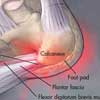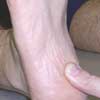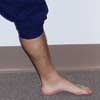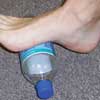Plantar Fasciitis: Office Management
ABSTRACT: Heel pain that occurs with the first several steps in the morning and diminishes as walking continues is the classic symptom of plantar fasciitis. Assessment of risk factors, such as improper footwear, a change in physical activities, and a new running surface, is important. Radiographs are rarely useful. Plantar fasciitis is generally self-limited; symptoms typically take 6 to 18 months to resolve. Conservative measures may include relative rest, stretching, strengthening, shoe modifications, orthoses, night splints, NSAIDs, and ice therapy. A corticosteroid injection may be warranted in resistant cases. If extensive conservative treatment is unsuccessful, referral to an orthopedic surgeon may be indicated.
Plantar fasciitis is the most common cause of heelpain in adults. The inflammation results from a biomechanical imbalance that causes tension along the plantar fascia and leads to collagen degeneration at the medial tubercle of the calcaneus.1
Plantar fasciitis occurs more frequently in women than in men.2 It is often seen in runners and dancers who use repetitive, maximal plantar flexion of the ankle and dorsiflexion of the metatarsophalangeal joints; in patients who experience sudden weight gain; and in overweight persons who increase their activity level.3
Here we discuss the typical presentation of plantar fasciitis and review the various treatment options.

Figure 1
PATHOPHYSIOLOGY
The plantar fascia originates from the medial calcaneal tuberosity, fans out across the sole of the foot, and inserts into the flexor mechanism of the toes at the metatarsal heads (Figure 1). This dense band of tissue supports the medial longitudinal arch of the foot and provides dynamic shock absorption.
At the beginning of the stance phase of the gait cycle, shortly after a heel strike, the tibia rotates internally and the foot pronates, stretching the plantar fascia as the foot flattens. Because the fascia has no elastic properties, repetitive stretching results in microtears at its origin. Repetitive microtears of the plantar fascia lead to collagen degeneration at the medial tubercle of the calcaneus, which eventually causes heel pain.
Predisposing factors that can excessively stretch a tight plantar fascia-and thus lead to repetitive microtears-may be extrinsic or intrinsic. Extrinsic factors include training errors, improper footwear, change in distance or intensity of physical activity, and change in running or walking surface.4 Intrinsic factors include pes cavus or pes planus, decreased plantar flexion strength, reduced flexibility of the plantar flexor muscles, tight Achilles tendon, excess pronation, discrepancy in leg length, torsional misalignments, and obesity or sudden weight gain (as in pregnancy).4
CLINICAL HISTORY
The classic symptom of plantar fasciitis is heel pain that occurs with the first several steps in the morning and lessens as walking continues, usually after 20 minutes. Patients often have pain at the beginning of an activity that diminishes or resolves as they warm up but generally recurs after the activity. The pain is usually insidious; a history of acute trauma is absent. Patients frequently describe the pain as a deep ache or tenderness at the anteromedial region of the calcaneus on the plantar surface of the foot. The pain may also occur with prolonged standing and can be accompanied by stiffness. In severe cases, the pain continues to worsen as activity progresses and becomes most intense at the end of the day.

Figure 2
EVALUATIONPhysical examination. Palpation over the medial tubercle of the calcaneus usually reproduces the pain of plantar fasciitis (Figure 2). In severe cases, palpation over the proximal portion of the plantar fascia also may reproduce the pain. Other maneuvers that may replicate the pain include passive dorsiflexion of the toes with weight bearing or having the patient stand on tiptoe and toe-walk. Affected patients may also have a flat foot, high arch, or excessively pronated foot. A tight heel cord with decreased dorsiflexion of the ankle is another potential finding. A typical presentation helps distinguish plantar fasciitis from other causes of heel pain, such as fat pad atrophy (often seen in the elderly) and bone lesions (eg, fracture, tumor, and infection).
Diagnostic imaging. Radiographs are rarely useful because they are generally normal or show a bony heel spur, which is not a source of the pain. Diagnostic imaging is indicated for patients with atypical presenting signs and symptoms of plantar fasciitis, for those with heel pain from other suspected causes, and for those who do not respond to appropriate treatment.
CONSERVATIVE TREATMENT
Plantar fasciitis is generally a self-limited condition. Unfortunately, resolution can take 6 to 18 months, which can be frustrating for patients and physicians. Although the condition is usually self-limited, it is a great mistake to undertreat it. The longer the symptoms exist, the more tearing has taken place and the less likely healing will occur. If symptoms have been present for longer than 12 months, the likelihood of resolution with nonoperative care dramatically decreases.3
A treatment plan that consists of relative rest, rather than complete rest alone, increases compliance. It is important to assess risk factors for plantar fasciitis. These may include a recent increase in weight-bearing activity, increased intensity of physical activity, walking or running on hard surfaces, and old or improper footwear. Early recognition of these factors increases the likelihood of success with conservative treatment.

Figure 3

Figure 4
The first goal of treatment is to correct training errors. This involves an assessment of the patient's activities and the substitution of alternatives for those that aggravate symptoms (eg, high-impact activities can be converted to low-impact activities, such as biking or swimming), the use of ice after activities (Box I), and an evaluation of the patient's shoes (Box II).5 Biomechanical factors can then be corrected with a stretching and strengthening program. If the patient's symptoms do not resolve, consider night splints or orthoses.
Stretching exercises. Increasing the flexibility of the calf muscle and stretching the Achilles tendon can correct functional risk factors, such as tightness of the gastrosoleal complex and weakness of the intrinsic foot muscles.1 Patients can be taught how to perform wall stretches and curb or stair stretches. For example, in one exercise, the patient faces a wall with one foot about 6 inches from the wall and the other foot about 2 feet from the wall; the patient then leans forward, while keeping both heels on the floor (Figure 3). The stretch is held for 2 minutes and is performed with each leg, 5 times daily. Dynamic stretches, such as rolling the foot arch over a 15-oz can or tennis ball, may also be helpful (Figure 4). In addition, the plantar fascia can be passively stretched with a towel.
Strengthening exercises. The following exercises emphasize intrinsic foot muscle strengthening:
- Towel curl: the patient places the foot flat on the end of a towel spread on a smooth surface. Keeping the heel on the floor, the patient pulls the towel toward the body by curling the toes.
- Marble pick-ups: the patient places a few marbles on the floor near a cup; keeping the heel on the floor, he or she then picks them up with the toes and drops them in the cup. For a greater challenge, patients can try using coins instead of marbles.
- Toe taps: the patient lifts up all the toes, keeping the heel on the floor; with the outside 4 toes in the air, the big toe is tapped repeatedly on the floor. The exercise is then reversed; the patient keeps the big toe in the air and taps the outside 4 toes on the floor.
In one study, 35% of patients cited strengthening programs as more helpful than stretching exercises, night splints, orthoses, NSAIDs, corticosteroid injection, and surgery.3
Orthoses and night splints. Patients with low arches have a decreased ability to absorb the forces generated by the impact of the foot strike. This can contribute to plantar fasciitis. Arch taping, over-the-counter (OTC) arch supports, and custom orthoses are the most commonly used mechanical corrections.
OTC arch supports may help patients with acute plantar fasciitis and pes planus.1 The support provided is highly variable depending on the material used. In general, patients should try to find the densest material that is soft enough to walk on and comfortable.A heel pad may also be helpful.
Custom orthoses-made from an impression of the patient's foot-are specifically designed to control biomechanical risk factors, such as pes planus and discrepancies in leg length. In patients with plantar fasciitis, the most common prescription is for semirigid, three-quarter to full-length orthoses with longitudinal arch support. Successful treatment of plantar fasciitis with orthoses depends on how well overpronation and metatarsal head motion are controlled.1
Night splints keep the ankle in a neutral position. A night dorsiflexion splint allows passive stretching of the calf and the plantar fascia while the patient sleeps. It prevents contraction of the plantar fascia that normally occurs in the relaxed foot position during sleep. Some studies have shown that about 80% of patients who used night splints obtained relief of symptoms.6,7 Other studies found that night splints were useful in persons who had plantar fasciitis for more than 12 months.8,9 Night splints may cause mild discomfort, which could interfere with the patient's ability to sleep.
NSAIDs. In patients who have no contraindications, NSAID therapy for 6 to 8 weeks along with other modalities can be helpful. In one study, 11% of patients cited NSAIDs as the treatment that worked best for them, and 79% of patients who used NSAIDs were in the successfully treated group.10 NSAIDs are convenient for patients to take; however, these agents pose the risk of GI bleeding, gastric pain, and renal damage.11
MORE AGGRESSIVE APPROACHES
Resistant cases of plantar fasciitis must be treated aggressively. After 3 months of minimal relief from NSAIDs, stretching, night splints, and shoe modifications or after 6 months of symptoms, patients should be offered a removable walking boot, short-leg walking cast, or crutches and a cast on the affected foot. Usually this is worn for 1 month, after which the situation is reassessed. If symptoms fail to resolve after 6 months of nonoperative care or if untreated symptoms persist for 12 months, consider referring the patient to an orthopedic surgeon for evaluation.
Corticosteroid injections. A corticosteroid injection should not be used in the initial treatment of plantar fasciitis because of associated risks. It is usually reserved for plantar fasciitis that persists after adequate biomechanical control is achieved. A plain radiograph of the foot or calcaneus must always be obtained before a corticosteroid injection to rule out other causes of heel pain, such as a tumor.1 Potential risks include rupture of the plantar fascia (found in 10% of patients after injection in one series)12 and fat pad atrophy. Corticosteroid injections are used as supplemental treatment only. A single injection may be warranted; multiple injections should be avoided.
References:
REFERENCES:1. Young CC, Rutherford DS, Niedfeldt MW. Treatment of plantar fasciitis. Am Fam Physician. 2001; 63:467-474.
2. Barrett SL, O'Malley R. Plantar fasciitis and other causes of heel pain. Am Fam Physician. 1999;59: 2200-2206.
3. Martin RL, Irrgang JJ, Conti SF. Outcome study of subjects with insertional plantar fasciitis. Foot Ankle Int. 1998;19:803-811.
4. Shea M, Fields KB. Plantar fasciitis: prescribing effective treatments. Phys Sportsmed. 2002;30:21-25.
5. Reid DC. Sports Injury Assessment and Rehabilitation. New York: Churchill Livingstone; 1992.
6. Gill LH, Kiebzak GM. Outcome of nonsurgical treatment for plantar fasciitis. Foot Ankle Int. 1996; 17:527-532.
7. Powell M, Post WR, Keener J, Wearden S. Effective treatment of chronic plantar fasciitis with dorsiflexion night splints: a crossover prospective randomized outcome study. Foot Ankle Int. 1998;19:10-18.
8. Batt ME, Tanji JL, Skattum N. Plantar fasciitis: a prospective randomized clinical trail of the tension night splint. Clin J Sports Med. 1996;6:158-162.
9. Wapner KL, Sharkey PF. The use of night splints for treatment of recalcitrant plantar fasciitis. Foot Ankle. 1991;12:135-137.
10. Wolgin M, Cook C, Graham C, Mauldin D. Conservative treatment of plantar heel pain: long-term follow-up. Foot Ankle Int. 1994;15:97-102.
11. McCarthy D. Nonsteroidal anti-inflammatory drug-related gastrointestinal toxicity: definitions and epidemiology. Am J Med. 1998;105:3S-9S.
12. Acevedo JI, Beskin JL. Complications of plantar fascia rupture associated with corticosteroid injection. Foot Ankle Int. 1998;19:91-97.
EVIDENCED-BASED MEDICINE
–Batt ME, Tanji JL, Skattum N. Plantar fasciitis: a prospective randomized clinical trail of the tension night splint. Clin J Sports Med. 1996;6:158-162.
–Powell M, Post WR, Keener J, Wearden S. Effective treatment of chronic plantar fasciitis with dorsiflexion night splints: a crossover prospective randomized outcome study. Foot Ankle Int. 1998;19: 10-18.